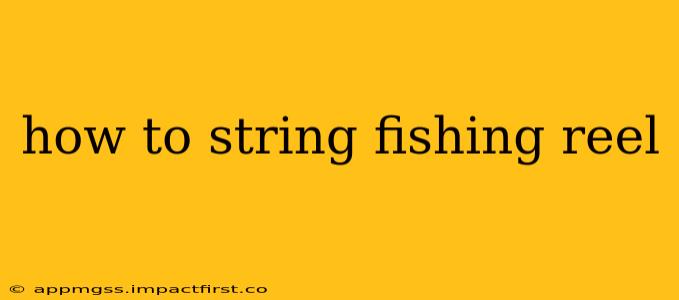Stringing a fishing reel might seem daunting at first, but with a little patience and the right steps, it becomes a straightforward process. This guide covers various reel types and offers tips for a smooth, successful stringing experience. Whether you're a seasoned angler or just starting out, understanding how to properly string your reel is crucial for optimal performance and longevity.
What Type of Fishing Reel Do You Have?
Before we dive into the specifics, it's vital to identify your reel type. The process varies slightly depending on whether you have a spinning reel, baitcasting reel, or spincast reel. Understanding your reel's mechanism will make the entire process significantly easier.
Spinning Reels
Spinning reels are the most common type for beginners and are generally easier to string. They feature a spool that rotates freely, allowing for smooth casting.
Baitcasting Reels
Baitcasting reels are known for their power and accuracy but require more skill to master, especially when it comes to stringing. These reels have a spool that is directly driven by the handle, making them more complex.
Spincast Reels
Spincast reels are a simple, enclosed design, ideal for beginners. They're generally the easiest to string, but the enclosed nature makes accessing the spool a little trickier.
How to String a Spinning Reel: A Step-by-Step Guide
This is generally the easiest type of reel to string.
-
Prepare the Line: Cut a length of fishing line significantly longer than needed. A good rule of thumb is to have at least 100 yards extra.
-
Attach the Line: Thread the line through the line guide closest to the spool (sometimes called the roller guide). Some reels have a small hole or notch where you need to feed the line through.
-
Filling the Spool: Carefully begin feeding the line onto the spool. It's crucial to keep the line even to avoid creating uneven tension.
-
Tightening the Spool: Once the spool is nearly full, secure the line by tying a knot (such as a Palomar knot) to the remaining line and leaving a small tag end.
-
Final Touches: Trim any excess line and ensure the line is evenly distributed on the spool. You want a fairly snug, yet not over-tightened spool.
How to String a Baitcasting Reel: A More Advanced Approach
Baitcasting reels demand more precision.
-
Prepare the Line & Secure the Spool: Begin by threading the line through the guides as with a spinning reel. On a baitcasting reel, you may need to use a small tool to open the spool. Secure the line to the spool with a strong knot like a clinch knot.
-
Tighten the Line: Many baitcasting reels have a small tension knob. Carefully adjust this knob to maintain a precise level of tension while filling the spool to avoid line slippage. Excessive tension can lead to issues with casting.
-
Even Distribution: This is crucial to avoid uneven casting and backlash. Aim for a smooth, even fill, paying close attention to how the line sits on the spool.
-
Test Cast: Before heading out fishing, conduct a few test casts to ensure that the line is feeding correctly and that your tension adjustment is optimal.
How to String a Spincast Reel: Simple and Efficient
Spincast reels are the easiest to string, but getting to the spool might require some extra steps.
-
Accessing the Spool: Many spincast reels have a cover or latch you need to open or remove to access the spool. Refer to your reel's instructions.
-
Thread the Line: Thread the line through any line guides found and directly onto the spool.
-
Filling the Spool: Fill the spool, and once it's almost full, close the reel cover or latch.
-
Testing and Tightness: Test the reel's operation before using it. Adjust as needed.
Troubleshooting Common Problems
- Line Knots: Use high-quality fishing line to reduce knotting.
- Uneven Spool: Carefully monitor the line distribution while filling the spool. If uneven, you may need to redistribute.
- Backlash (Baitcasting Reels): This is often caused by improper spool tension. Adjust the tension knob until casting smoothly.
Frequently Asked Questions (FAQ)
What kind of line should I use for my fishing reel?
The best line type depends on your fishing style and target species. Monofilament is a popular choice for its versatility, while braided line offers superior strength and sensitivity. Fluorocarbon line is less visible underwater.
How often should I re-spool my fishing reel?
The frequency depends on use, but it’s generally advisable to re-spool at least once a year or when you notice significant wear and tear on the existing line. Look for fraying, nicks, or weakened spots.
What are the signs of a worn-out fishing line?
Look for signs of fraying, stiffness, discoloration, or excessive memory. A weakened line can easily break under pressure.
Remember to always consult your reel's manual for specific instructions and recommendations. With practice, stringing your fishing reel will become second nature, ensuring you're always ready for your next angling adventure.
